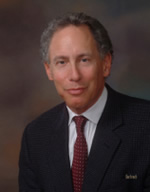About the 1st Awardee
The winner of the 1st Terumo Global Science Prize is Dr. Robert Samuel Langer, Professor at MIT (Massachusetts Institute of Technology). Dr. Langer's career, achievements, and the reasons for prize winning are described below.

Dr. Robert Samuel Langer
Date of Birth August 29, 1948 (New York, USA)
Career
- 1970
- Cornell University (B.A.)
- 1974
- Massachusetts Institute of Technology (MIT) (PhD in Chemical Engineering supervised by Professor Clark K. Colton)
- 1974-1977
- Children's Hospital Boston/Harvard Medical School
Postdoctoral fellow
(supervised Professor Judah Folkman)
- 1977-1981
- MIT Nutritional Biochemistry Assistant Professor
- 1981-1985
- MIT Biochemical Engineering Associate Professor
- 1985-1988
- MIT Biochemical Engineering,
Harvard-MIT Health Science and Technology Professor
- 1988-2005
-
MIT Chemical and Biochemical Engineering,
Helen Whitaker University (Health Science and Technology Management)
Harvard-MIT Health Science and Technology Professor
- 2005-
- MIT Institute Professor
At present, Dr. Langer is one of 14 Institute Professors (holding the position of Institute Professor is the highest honor) and belongs to the Department of Chemical Engineering of MIT. Dr. Langer is specialized in the field that integrates biotechnology and material science. He has published more than 1,100 papers and obtained/applied for about 800 international patents. In addition, he chaired the FDA Science Board from 1999 to 2002.
Moreover, Forbes Magazine named Dr. Langer as "one of the 25 most important individuals in biotechnology in the world." Forbes Magazine also selected Dr. Langer as "one of the 15 innovators world wide who will reinvent our future." Discover Magazine named Dr. Langer as "one of the 20 most important people in this area." Time Magazine and CNN named Dr. Langer as "one of the 100 most important people in America."
Prize Records
Dr. Langer has received more than 200 eminent awards. He has an h-index of 127. The major awards are listed below.
- 1990
- Clemson Award
(the highest honor conferred by the Society for Biomaterials)
- 1996
- Gardiner Foundation International Award
(Canada's largest medical award comparable to the Nobel Prize; He is currently the only engineer who has received the award.)
- 2002-
- Charles Stark Draper Prize (comparable to the "Nobel Prize" in the field of engineering)
- 2005
- Albany Medical Center Prize (Medical Prize in USA)
- 2006
- National Medal of Science,
- 2008
- Millennium Technology Prize (the world's largest technology prize)
"For his invention and development of innovative biomaterials for controlled drug release and tissue regeneration that have significantly improved human health"
- 2012
- Priestley Medal (the highest honor conferred by the American Chemical Society)
(And many others)
Achievements and the Reasons for Prize Winning
In the past, Dr. Langer has received many awards. He has contributed to advancement in biomaterials, tissue engineering, and regenerative medicine for more than 30 years and has been a leader of academic society and related industries. For such contributions, Dr. Langer has been praised as "the father (a front-line researcher in the field) of tissue engineering" and "the pioneer (innovator) of controlled drug release delivery and tissue engineering" by the National Academy of Sciences. In addition, Dr. Langer has supervised more than 100 PhD students. More than 200 members supervised in his laboratory have become professors and leaders (teachers) in various high-ranked academic institutions. Dr. Langer also has cultivated many human resources for the next generation.
In 1993, Dr. Langer et al. including Professor J. Vacanti at Harvard University wrote a seminal paper entitled "Tissue Engineering" in Science Magazine. Then, Dr. Langer conducted a joint study to create a mouse with an ear-formed implant by forming a biodegradable lactic acid-glycolic acid copolymer in the shape of a human ear and implanting it subcutaneously with cartilage cells on the back of a nude mouse. This was reported through the media all over the world. It created an international research boom in the field of tissue engineering. Specifically, he proposed the creation of tissue with a combination of cells + matrix +cytokine (physiologically active substances).
After 1986, Dr. Langer demonstrated the formation of about 20 types of body tissues using animal models. His group succeeded for the first time in the creation of cartilage, cardiac valve, bone, liver, intestine, urinary system, tendon, and muscle by tissue engineering. As a result of this study, the creation of human skin, bone, blood vessel, urinary bladder, and cartilage has been achieved. In 2002, Dr. Langer created a completely new biodegradable material called "Biorubber," contributing to advancement in scaffolding technology for tissue engineering. Furthermore, he developed methods such as the novel method for forming muscles using stem cells in 2005, the world's first high-throughput method for creating a material regulating stem cell differentiation in 2004, the method for forming cardiac tissue using biomaterials in 2008, and a novel method of biomaterial surface synthesis for stem cell growth in a unique environment containing no foreign bodies and serum in 2010.
The advantageous use of such techniques is expected to allow the creation of 3D constructs that can be used for repair or substitution of damaged organs in the future. This will lead to the establishment of new therapeutic methods.
Dr. Langer has developed various new techniques used in tissue engineering for many years. In addition, he has supervised many people all over the world in the field of clinical research that forms the academic foundation of the field of material chemistry and tissue engineering. Dr. Langer is the best person to receive the 1st Terumo International Prize. Our foundation is highly honored to present the award to Dr. Langer.

